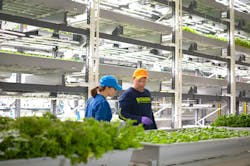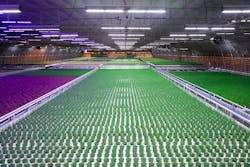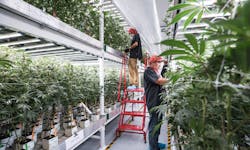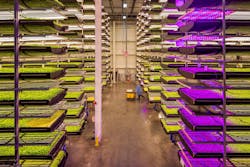Think “grow lights,” and two very different images may appear. One is of a mild-mannered plant lover obsessing over how to get her indoor greenery through the winter darkness; the other a scofflaw pothead tending temperamental marijuana plants in a spare bedroom. Now, another image — a dollar sign — is starting to take shape.
Artificial lighting to mimic sunlight is an increasingly central and sophisticated component of controlled environment agriculture (CEA), an industry in expansion mode due to evolving laws, advancing technology, heightened environmental awareness, and changing agricultural market economics. From supplementing sunlight in greenhouses to being the sole light source in indoor farms to delivering doses and types of light suited to different plant growth stages, man-made light is becoming a core input for CEA production of everything from greens and herbs to ornamentals and cannabis.
But what once amounted to indiscriminately bathing plants in light generated from high-pressure sodium, metal-halide, or fluorescent luminaires is evolving into a careful process of vetting options and selecting the ideal light source, type, fixture design, and configuration. And what’s fundamentally changing the calculation, of course, is the emergence of lighting’s big disruptor: the LED.
While LEDs have been punching through barriers to adoption in many lighting applications, they remain a tiny part of horticulture’s lighting mix. Its comparatively high up-front cost, combined with a traditionalist mentality and wariness of new technology in the producer community, has left LED stalled, but coiled on the fringes of the traditional greenhouse market for both new and replacement lighting. But as LED prices fall and more becomes clear about its energy efficiency and other qualities that can benefit producers, this lighting choice is starting to make inroads into a market that could be on the cusp of a breakout. The possible result: big opportunity for producers to improve their bottom lines, and a blossoming new LED market for lighting manufacturers, designers, and contractors.
“We’ve seen a steady transition from conventional lighting to LED in many general lighting application markets, and we may now be at the beginning of that transition in horticulture lighting,” says Morgan Pattison, principal at Solid State Lighting Services, Inc., a consulting firm that contributed to a 2017 U.S. Department of Energy analysis of prospects for solid-state lighting in horticulture. “We have a scenario where LEDs are getting better, and there’s this old technology of greenhouse lighting that basically is the equivalent of streetlights.”
Yet it may be too early to write the obituary for legacy lighting in CEA. Even if acreage expands to meet growing demand, as numerous market studies predict, producers who have a choice may be slow to upgrade to LEDs or select them for new projects. High initial capital outlays, uncertain payback periods, and a gap between true lighting needs and wants may mean the market for traditional forms of lighting will stay firm and might even grow.
“There’s an opportunity to push out legacy lighting in horticulture, but it’s likely that it will have a major role to play for some time,” says Philip Smallwood, research director with Strategies Unlimited, which has analyzed the market for horticulture lighting. “Over 95% of the global market remains legacy lighting.”
LED Tailor Made
In spite of that fact — or because of if — LEDs are generating palpable excitement in some CEA circles. Offering a host of attributes producers may value to varying degrees — such as energy efficiency, minimal heat production, light spectrum tunability, and control to name a few — LEDs are seen as a light source uniquely adaptable to the demands of sunlight-free or -restricted plant production.
Its current and prospective role in the market is varied. Vertical farming, an emerging concept of stacked, high-density indoor plant production that uses no natural sunlight, has been mid-wived by LED’s ability to optimally deliver light from luminaires positioned in close proximity to plants. Artificial light-supplemented greenhouses, a small, but growing sub-sector of a production approach that mostly uses natural light, are candidates for moving away from clunky legacy lighting to energy-saving, cool-operating, and tunable LED sources. And so-called non-stacked indoor farming, which utilizes only artificial light, and has been surging with more legal cannabis production, could find LED to be an economically superior alternative to incumbent high-intensity discharge (HID) lighting; LEDs in that setting may prove particularly valuable for delivering precisely tuned and timed, growth-stage-appropriate light to cannabis plants.
Indeed, across the board in CEA, LED could prove to be a game changer — to what degree depends on several factors, chief among them the payback period for investing in a lighting solution that is more expensive in the short run. That’s an important consideration, particularly for producers who grow products yielding razor-thin margins in the market. Even with attributes that bring reduced long-term operating expenses or contribute to the production of more and better products, LEDs may continue to be a hard sell for some operations.
But one budding corner of CEA that will flock to the LED approach as it expands is vertical farming, a style built around soilless growing of selected products such as lettuce and other leafy greens and herbs. Since light-generated heat (and its potentially harmful effect on growing plants) is a big logistical obstacle for such operations, cooler LED light is ideally suited to the task. Producing less heat than light from other sources, namely fluorescent, configured to sit inches from the tops of plants, LED lighting lessens heat stress on plants while generating less heat buildup in the facility, resulting in lower costs to keep facilities in a critical temperature range.
That’s a big reason LED is highly used in vertical farming today and is on track to be that sector’s dominant lighting source. In a 2018 research paper on the global horticulture lighting market, Strategies Unlimited estimated that 86% of the lighting in use in North American vertical farms is LED, with the balance being fluorescent lighting. And it forecasts that as the industry grows, LED usage will expand, comprising 99% of the installed base of lighting by 2022.
“If prices continue to come down on LED that would be an important factor in the continued growth of vertical farming, and we’re seeing that,” says Smallwood.
Vertical Farming Challenges
But the path forward for vertical farming, which by some estimates totals a mere 10 acres in the United States, is foggy. The concept rests on the assumption that a highly controlled, quality-, yield-, and volume-oriented production environment can consistently turn out products that command market prices high enough to offset production costs. That’s a challenge when selling commodity-like products that typically carry tight margins. But it’s one made easier if input costs, lighting and cooling/heating being among the largest, can be tightly controlled. More affordable LED lighting would help producers from a first-cost and investment payback-time perspective. But since lighting is essential for production, and LED is almost certainly its only viable source, comparative payback scenarios aren’t an issue.
The pace of future LED price action is hard to gauge, as is how much bearing that would have on the growth prospects for vertical farming. Strategies Unlimited’s research didn’t draw a connection, but does see the average price per square foot for installing LEDs in North American vertical farm operations falling from $15.72 this year to $13.48 in 2022, and square footage of North American vertical farm lighting of all kinds totaling 20.2 million-square-feet by that time, up from an estimated installed base in 2017 of 1.3-million-square-feet.
Falling LED prices would almost surely help the math pencil out for vertical farm operators, but deeper understanding of LED-generated light and how to use it in horticulture, combined with continued product development, could also influence the growth trajectory.
A key selling point for LEDs, generally, is their ability to be configured to deliver finely and extensively varied and differentiated concentrations, mixtures, and intensities of light. That has propelled LED’s fortunes in markets for lighting “consumed” by human beings, but now that knowledge is expanding to include how plants react to light.
Laboratory research and real-world scenarios offer growing evidence that light “recipes” adjusted for a host of tunable variables and even targeted to different plant growth stages can optimize the plant maturity process and ultimately influence product quality factors. These light mixtures — “prescriptions” in a sense — determined through advancements in understanding of how plants utilize light are even being touted as potentially superior to the comparatively full-spectrum natural white light plants receive from the sun during growth.
Most existing vertical farming operations, eager to prove the commercial viability of the concept, are extensively utilizing highly curated LED lighting. One market leader, AeroFarms, LLC, Newark, N.J., describes its approach to lighting as one of engineering the perfect light mixture for each plant that delivers “exactly the spectrum, intensity, and frequency they need for photosynthesis in the most energy-efficient way possible that allows us to control size, shape, texture, color, flavor, and nutrition with razor-sharp precision and increased productivity.”
A November 18 Washington Post story on the vertical farming phenomenon referenced work by researchers at Michigan State University to understand the nuances of LED light recipes and their effects on plants. One finding noted is that varied intensity mixtures of red, blue, and green light produced different feature expressions in a red leaf lettuce variety, relating to leaf size and shape and coloring, and even yield.
This ability to capture LED’s uniquely adjustable qualities — coupled with tangible gains in product quality, production intensity, and yield — could ultimately prove more valuable to vertical farming operations than energy savings, especially since LED is the only practical grow-lighting solution.
“The biggest selling point (especially for vertical farms) may be increased productivity,” Smallwood says. “The light spectrum matters and that has an impact on how quickly plants bloom and the quality of the plant through different phases of its life cycle. That [understanding] could drive deeper penetration of LEDs, even at higher price points.”
Cost Concerns
But LED’s potential plant growth-enhancing attributes might not be enough to overcome initial cost-outlay considerations in more traditional CEA applications.
In sunlight-free, non-stacked indoor farms, lighting is chiefly delivered from ceiling-mounted HID or fluorescent luminaires. The main variable is luminaire density, which can be adjusted to produce amounts of light determined to be optimal for plants being grown. While more energy-efficient LED could substantially reduce lighting costs that can be exorbitant due to long hours of operation, and also deliver more targeted light mixtures that could have positive production-related consequences, it has attracted little interest so far. The U.S. Department of Energy’s (DOE) 2017 study, “Energy Savings
Potential of SSL in Horticultural Applications,” estimated only about 4% of indoor farm lighting is LED. The suspected reason: growers bristle at LED’s high first-cost and worry that it might not help — or could even harm — plants.
“Interest in LED has been tempered by the technology failing to live up to promises made by some manufacturers,” says Pattison. “But lighting performance in this application can be difficult to communicate, and there’s been a lack of standard metrics.”
But the DOE report Pattison helped author suggests producers are missing an opportunity to save on a major input cost. If lighting used to grow plants on nearly 19 million feet of indoor farming area in the U.S. in 2017 had been LED, electricity usage would have totaled 3,100 GWh, 41% less than the 5,300 GWh estimated to be consumed by lighting that was 96% non-LED.
The Cannabis Factor
If there is a move to LED in indoor farming, cannabis production will likely be one of the major reasons. Much of it is now grown, at least partially depending on plant stage, in totally controlled, sunlight-free environments, although more is seen shifting over time to greenhouses and vertical farms. Whatever the location, LED might be well-suited to cannabis production because the plant can be sensitive and demanding, and crop quality is heavily dependent on carefully managed growing conditions.
“Cannabis requires one of the highest light levels of light of any crop, an intensity of about 65 watts-per-square foot,” says Doug Oppedal, senior lighting specialist with Evergreen Consulting, Portland, Ore., who has helped start-up cannabis operations craft energy-saving grow lighting solutions that utilities concerned about their contribution to energy load will reward.
Energy savings from LED is a big draw for heavily light-dependent cannabis growers, but lighting cost is a concern moderated some by the high margins cannabis can command. But LED’s promise of potentially juicing yields and improving product quality through spectral tuning is an important consideration as well.
“Energy usage is secondary in cannabis production,” Oppedal says. “Spectral needs are key, and LED is in many ways there now in terms of its ability to deliver on that.”
Strategies Unlimited sees a steady pickup in LED adoption among U.S. cannabis producers over the next few years. Accounting for an estimated 10% of the 6.2-million-square feet of lighting deployed in cannabis operations in 2017, LED is seen accounting for 45% of installed lighting by 2022. Over that time span, indoor farms’ share of all lighting dedicated to cannabis is seen static at around 35%, while vertical farms’ and supplemented-light greenhouses’ share will steadily grow.
“Cannabis growers have learned how to grow in controlled-light environments, but as the market matures more are realizing they can grow in greenhouses,” Smallwood says. “Many still prefer high-pressure sodium lighting because that’s what’s always been used, but interest in LED is growing.”
LED may face its heaviest lift in light-supplemented greenhouses, where first costs of artificial light are more of a concern because lighting needs are limited and payback is longer. But if LED attributes become clearer and costs come down, calculations could change — opening a window that might open in replacement, new construction and even longer-operating-time scenarios. As it stands, LED accounts for just 2% of greenhouse lighting, according to the DOE report on SSL in horticulture. If all greenhouse lighting was switched to LED, energy usage for electric lighting would drop 29%, the report stated.
“Most new greenhouses being built today are incorporating lighting, but not a lot are going with LED,” Pattison says. “There’s little spectral benefit from it because most light is being provided by the sun.”
The sun will surely continue to provide the light most commercially grown plants need, but artificial light could shoulder more of a role. Strategies Unlimited projects that by 2020, global installations of CEA lighting will have grown at a five-year compounded annual rate of 6%, and that LED will comprise 17% of all horticulture lighting, up from 1% in 2017. Whether that comes to pass will depend on the value-add CEA can ultimately deliver to producers and their customers — and whether the technology essential to the production process, not least of all lighting, becomes more useful, attainable, and affordable.
Zind is a freelance writer based in Lees Summit, Mo. He can be reached at [email protected].
Sidebar: Standards Action Points to Horticulture Lighting Growing Up
Horticulture lighting’s maturation process may be quickening. In fact, standards designed to steer controlled environment agriculture (CEA) lighting buyers to products that meet specialized lighting needs are starting to appear, signaling that demand for the lighting and more clarity and transparency in product selection is growing.
One of the most consequential comes from DesignLights Consortium (DLC), an advocacy group that vets solid-state lighting products for energy efficiency and other quality measures. The organization debuted testing and reporting requirements for LED-based horticultural lighting last fall. Another comes from The American Society of Agricultural and Biological Engineers. ASABE has released another installment of standards it’s developing that address measurement and testing of LEDs for plant growth and development. Both reflect the understanding that buyers need to assess lighting on two broad measures: how well it delivers usable light to target plants, and, because CEA lighting usage is intensive, how much electrical energy is needed to produce the required effect.
As with lighting for human needs, lighting efficiency and efficacy are key, but a different yardstick is needed. Rather than lumen output and wattage, gauges like photosynthetic active radiation, daily light integral and photosynthetic photon flux density are critical. Those have guided lighting manufacturer product development, but a lack of standards to design to has left buyers uncertain about performance and which products might qualify for energy efficiency incentives from utilities.
“The lighting industry has moved faster than the standards bodies could work,” leaving buyers to wonder if products would perform as billed, says Damon Bosetti, a DLC horticulture lighting program manager. “Standards will set minimum performance thresholds and answer the question of whether lighting will make photons efficiently and do so in an energy-efficient manner.”
In mid-March, DLC formally announced the first lighting products to meet its specification: a line of luminaires from MaxLite, Inc., that are at least 10% more energy efficient than 1,000W HID fixtures commonly used in horticulture applications.
Preceding specifications on performance, in 2017 Underwriters Laboratories and Intertek issued safety specifications for horticulture lighting, which must operate in environments that can degrade luminaires and pose electrical safety risks.
About the Author
Tom Zind
Freelance Writer
Zind is a freelance writer based in Lee’s Summit, Mo. He can be reached at [email protected].




